Write a program that randomly generates a maze in javaSoluti
Write a program that randomly generates a maze in java
Solution
import java.util.ArrayList;
import java.util.Collections;
import java.util.Comparator;
import java.util.Random;
public class MyMaze {
private int dimensionX, dimensionY; // dimension of maze
private int gridDimensionX, gridDimensionY; // dimension of output grid
private char[][] grid; // output grid
private Cell[][] cells; // 2d array of Cells
private Random random = new Random(); // The random object
// initialize with x and y the same
public MyMaze(int aDimension) {
// Initialize
this(aDimension, aDimension);
}
// constructor
public MyMaze(int xDimension, int yDimension) {
dimensionX = xDimension;
dimensionY = yDimension;
gridDimensionX = xDimension * 4 + 1;
gridDimensionY = yDimension * 2 + 1;
grid = new char[gridDimensionX][gridDimensionY];
init();
generateMaze();
}
private void init() {
// create cells
cells = new Cell[dimensionX][dimensionY];
for (int x = 0; x < dimensionX; x++) {
for (int y = 0; y < dimensionY; y++) {
cells[x][y] = new Cell(x, y, false); // create cell (see Cell constructor)
}
}
}
// inner class to represent a cell
private class Cell {
int x, y; // coordinates
// cells this cell is connected to
ArrayList<Cell> neighbors = new ArrayList<>();
// solver: if already used
boolean visited = false;
// solver: the Cell before this one in the path
Cell parent = null;
// solver: if used in last attempt to solve path
boolean inPath = false;
// solver: distance travelled this far
double travelled;
// solver: projected distance to end
double projectedDist;
// impassable cell
boolean wall = true;
// if true, has yet to be used in generation
boolean open = true;
// construct Cell at x, y
Cell(int x, int y) {
this(x, y, true);
}
// construct Cell at x, y and with whether it isWall
Cell(int x, int y, boolean isWall) {
this.x = x;
this.y = y;
this.wall = isWall;
}
// add a neighbor to this cell, and this cell as a neighbor to the other
void addNeighbor(Cell other) {
if (!this.neighbors.contains(other)) { // avoid duplicates
this.neighbors.add(other);
}
if (!other.neighbors.contains(this)) { // avoid duplicates
other.neighbors.add(this);
}
}
// used in updateGrid()
boolean isCellBelowNeighbor() {
return this.neighbors.contains(new Cell(this.x, this.y + 1));
}
// used in updateGrid()
boolean isCellRightNeighbor() {
return this.neighbors.contains(new Cell(this.x + 1, this.y));
}
// useful Cell representation
@Override
public String toString() {
return String.format(\"Cell(%s, %s)\", x, y);
}
// useful Cell equivalence
@Override
public boolean equals(Object other) {
if (!(other instanceof Cell)) return false;
Cell otherCell = (Cell) other;
return (this.x == otherCell.x && this.y == otherCell.y);
}
// should be overridden with equals
@Override
public int hashCode() {
// random hash code method designed to be usually unique
return this.x + this.y * 256;
}
}
// generate from upper left (In computing the y increases down often)
private void generateMaze() {
generateMaze(0, 0);
}
// generate the maze from coordinates x, y
private void generateMaze(int x, int y) {
generateMaze(getCell(x, y)); // generate from Cell
}
private void generateMaze(Cell startAt) {
// don\'t generate from cell not there
if (startAt == null) return;
startAt.open = false; // indicate cell closed for generation
ArrayList<Cell> cells = new ArrayList<>();
cells.add(startAt);
while (!cells.isEmpty()) {
Cell cell;
// this is to reduce but not completely eliminate the number
// of long twisting halls with short easy to detect branches
// which results in easy mazes
if (random.nextInt(10)==0)
cell = cells.remove(random.nextInt(cells.size()));
else cell = cells.remove(cells.size() - 1);
// for collection
ArrayList<Cell> neighbors = new ArrayList<>();
// cells that could potentially be neighbors
Cell[] potentialNeighbors = new Cell[]{
getCell(cell.x + 1, cell.y),
getCell(cell.x, cell.y + 1),
getCell(cell.x - 1, cell.y),
getCell(cell.x, cell.y - 1)
};
for (Cell other : potentialNeighbors) {
// skip if outside, is a wall or is not opened
if (other==null || other.wall || !other.open) continue;
neighbors.add(other);
}
if (neighbors.isEmpty()) continue;
// get random cell
Cell selected = neighbors.get(random.nextInt(neighbors.size()));
// add as neighbor
selected.open = false; // indicate cell closed for generation
cell.addNeighbor(selected);
cells.add(cell);
cells.add(selected);
}
}
// used to get a Cell at x, y; returns null out of bounds
public Cell getCell(int x, int y) {
try {
return cells[x][y];
} catch (ArrayIndexOutOfBoundsException e) { // catch out of bounds
return null;
}
}
public void solve() {
// default solve top left to bottom right
this.solve(0, 0, dimensionX - 1, dimensionY -1);
}
// solve the maze starting from the start state (A-star algorithm)
public void solve(int startX, int startY, int endX, int endY) {
// re initialize cells for path finding
for (Cell[] cellrow : this.cells) {
for (Cell cell : cellrow) {
cell.parent = null;
cell.visited = false;
cell.inPath = false;
cell.travelled = 0;
cell.projectedDist = -1;
}
}
// cells still being considered
ArrayList<Cell> openCells = new ArrayList<>();
// cell being considered
Cell endCell = getCell(endX, endY);
if (endCell == null) return; // quit if end out of bounds
{ // anonymous block to delete start, because not used later
Cell start = getCell(startX, startY);
if (start == null) return; // quit if start out of bounds
start.projectedDist = getProjectedDistance(start, 0, endCell);
start.visited = true;
openCells.add(start);
}
boolean solving = true;
while (solving) {
if (openCells.isEmpty()) return; // quit, no path
// sort openCells according to least projected distance
Collections.sort(openCells, new Comparator<Cell>(){
@Override
public int compare(Cell cell1, Cell cell2) {
double diff = cell1.projectedDist - cell2.projectedDist;
if (diff > 0) return 1;
else if (diff < 0) return -1;
else return 0;
}
});
Cell current = openCells.remove(0); // pop cell least projectedDist
if (current == endCell) break; // at end
for (Cell neighbor : current.neighbors) {
double projDist = getProjectedDistance(neighbor,
current.travelled + 1, endCell);
if (!neighbor.visited || // not visited yet
projDist < neighbor.projectedDist) { // better path
neighbor.parent = current;
neighbor.visited = true;
neighbor.projectedDist = projDist;
neighbor.travelled = current.travelled + 1;
if (!openCells.contains(neighbor))
openCells.add(neighbor);
}
}
}
// create path from end to beginning
Cell backtracking = endCell;
backtracking.inPath = true;
while (backtracking.parent != null) {
backtracking = backtracking.parent;
backtracking.inPath = true;
}
}
// get the projected distance
// (A star algorithm consistent)
public double getProjectedDistance(Cell current, double travelled, Cell end) {
return travelled + Math.abs(current.x - end.x) +
Math.abs(current.y - current.x);
}
// draw the maze
public void updateGrid() {
char backChar = \' \', wallChar = \'X\', cellChar = \' \', pathChar = \'*\';
// fill background
for (int x = 0; x < gridDimensionX; x ++) {
for (int y = 0; y < gridDimensionY; y ++) {
grid[x][y] = backChar;
}
}
// build walls
for (int x = 0; x < gridDimensionX; x ++) {
for (int y = 0; y < gridDimensionY; y ++) {
if (x % 4 == 0 || y % 2 == 0)
grid[x][y] = wallChar;
}
}
// make meaningful representation
for (int x = 0; x < dimensionX; x++) {
for (int y = 0; y < dimensionY; y++) {
Cell current = getCell(x, y);
int gridX = x * 4 + 2, gridY = y * 2 + 1;
if (current.inPath) {
grid[gridX][gridY] = pathChar;
if (current.isCellBelowNeighbor())
if (getCell(x, y + 1).inPath) {
grid[gridX][gridY + 1] = pathChar;
grid[gridX + 1][gridY + 1] = backChar;
grid[gridX - 1][gridY + 1] = backChar;
} else {
grid[gridX][gridY + 1] = cellChar;
grid[gridX + 1][gridY + 1] = backChar;
grid[gridX - 1][gridY + 1] = backChar;
}
if (current.isCellRightNeighbor())
if (getCell(x + 1, y).inPath) {
grid[gridX + 2][gridY] = pathChar;
grid[gridX + 1][gridY] = pathChar;
grid[gridX + 3][gridY] = pathChar;
} else {
grid[gridX + 2][gridY] = cellChar;
grid[gridX + 1][gridY] = cellChar;
grid[gridX + 3][gridY] = cellChar;
}
} else {
grid[gridX][gridY] = cellChar;
if (current.isCellBelowNeighbor()) {
grid[gridX][gridY + 1] = cellChar;
grid[gridX + 1][gridY + 1] = backChar;
grid[gridX - 1][gridY + 1] = backChar;
}
if (current.isCellRightNeighbor()) {
grid[gridX + 2][gridY] = cellChar;
grid[gridX + 1][gridY] = cellChar;
grid[gridX + 3][gridY] = cellChar;
}
}
}
}
}
// simply prints the map
public void draw() {
System.out.print(this);
}
// forms a meaningful representation
@Override
public String toString() {
updateGrid();
String output = \"\";
for (int y = 0; y < gridDimensionY; y++) {
for (int x = 0; x < gridDimensionX; x++) {
output += grid[x][y];
}
output += \"\ \";
}
return output;
}
// run it
public static void main(String[] args) {
MyMaze maze = new MyMaze(20);
maze.solve();
System.out.print(maze);
}
}
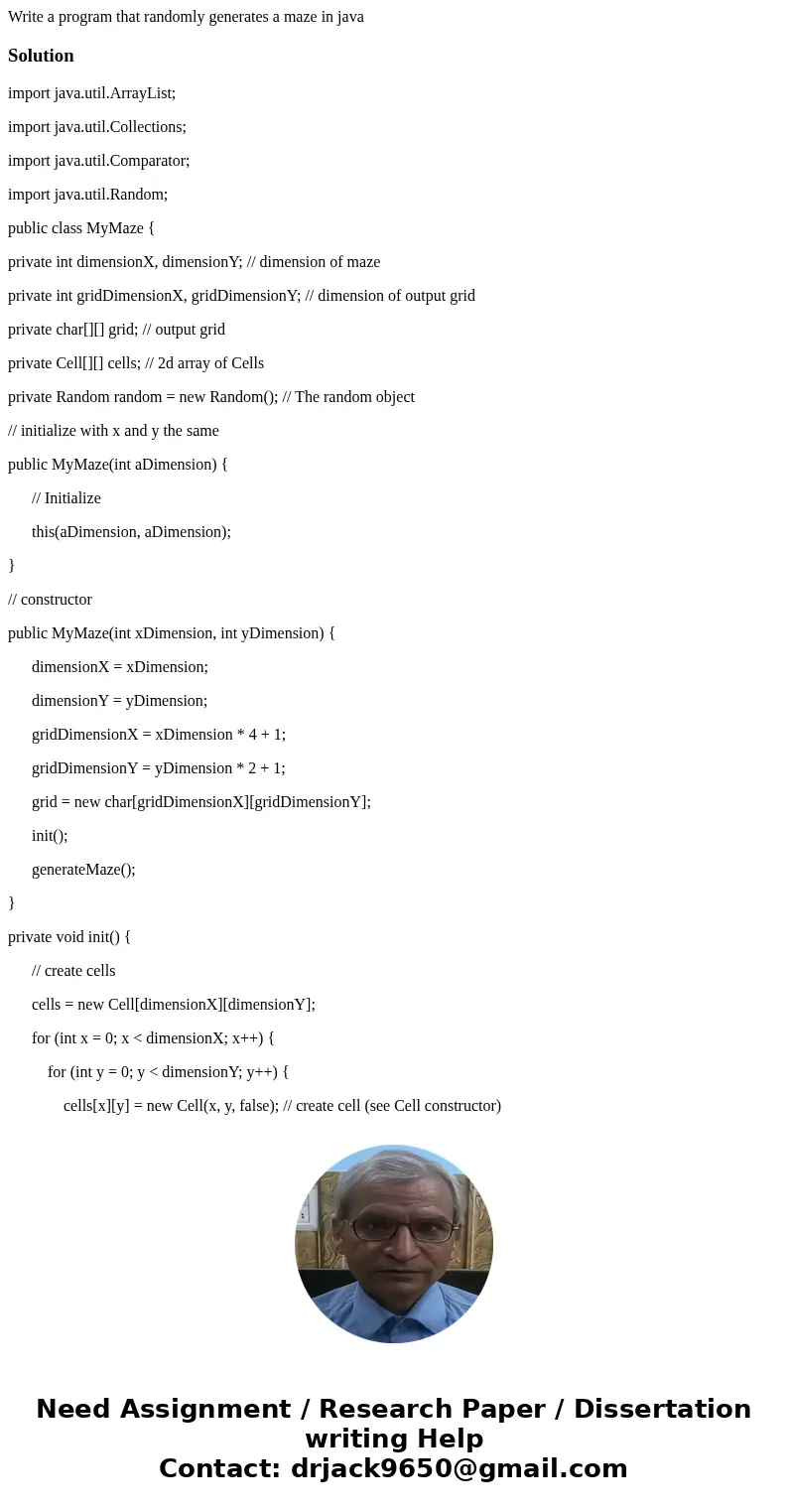
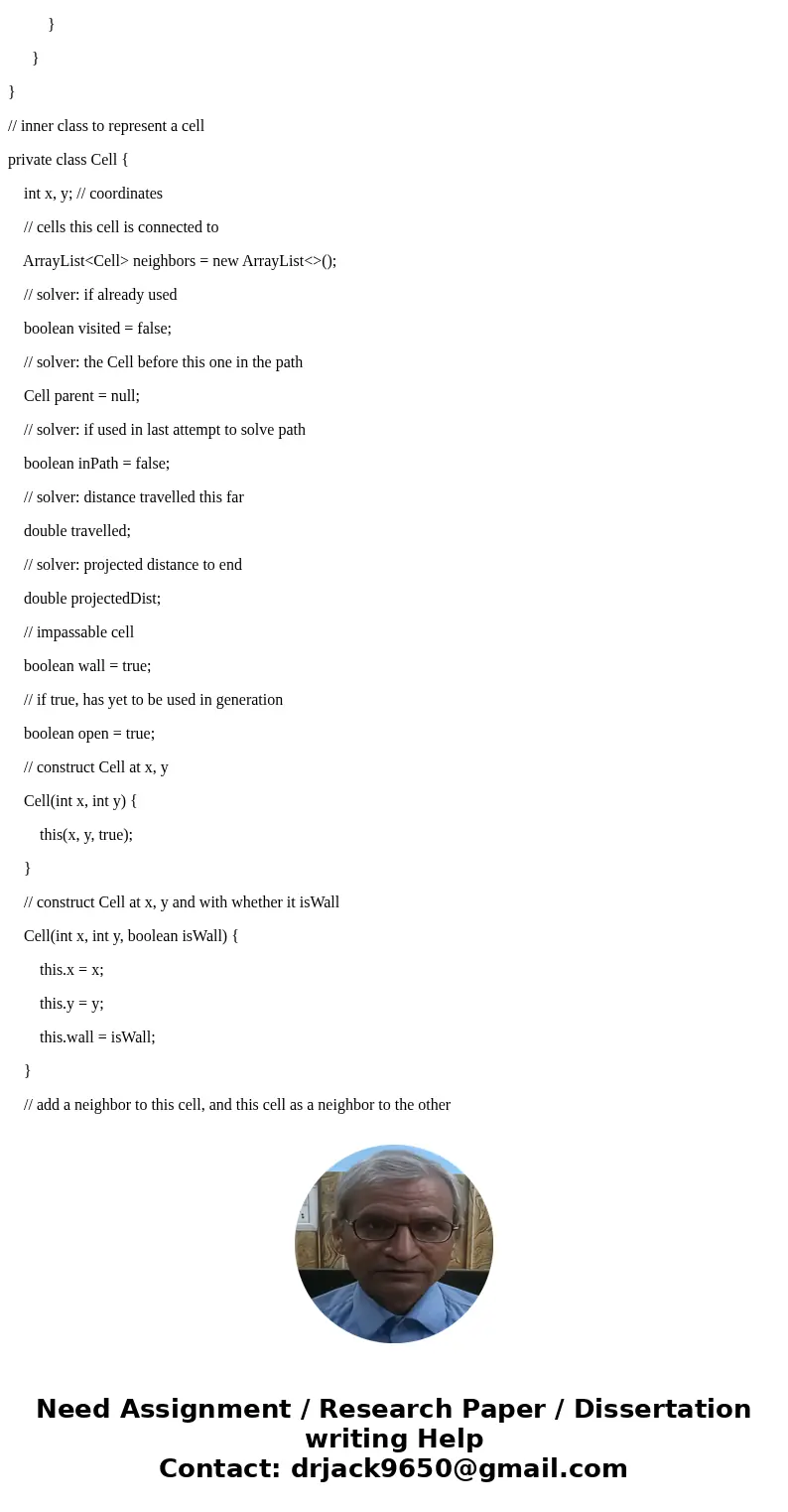
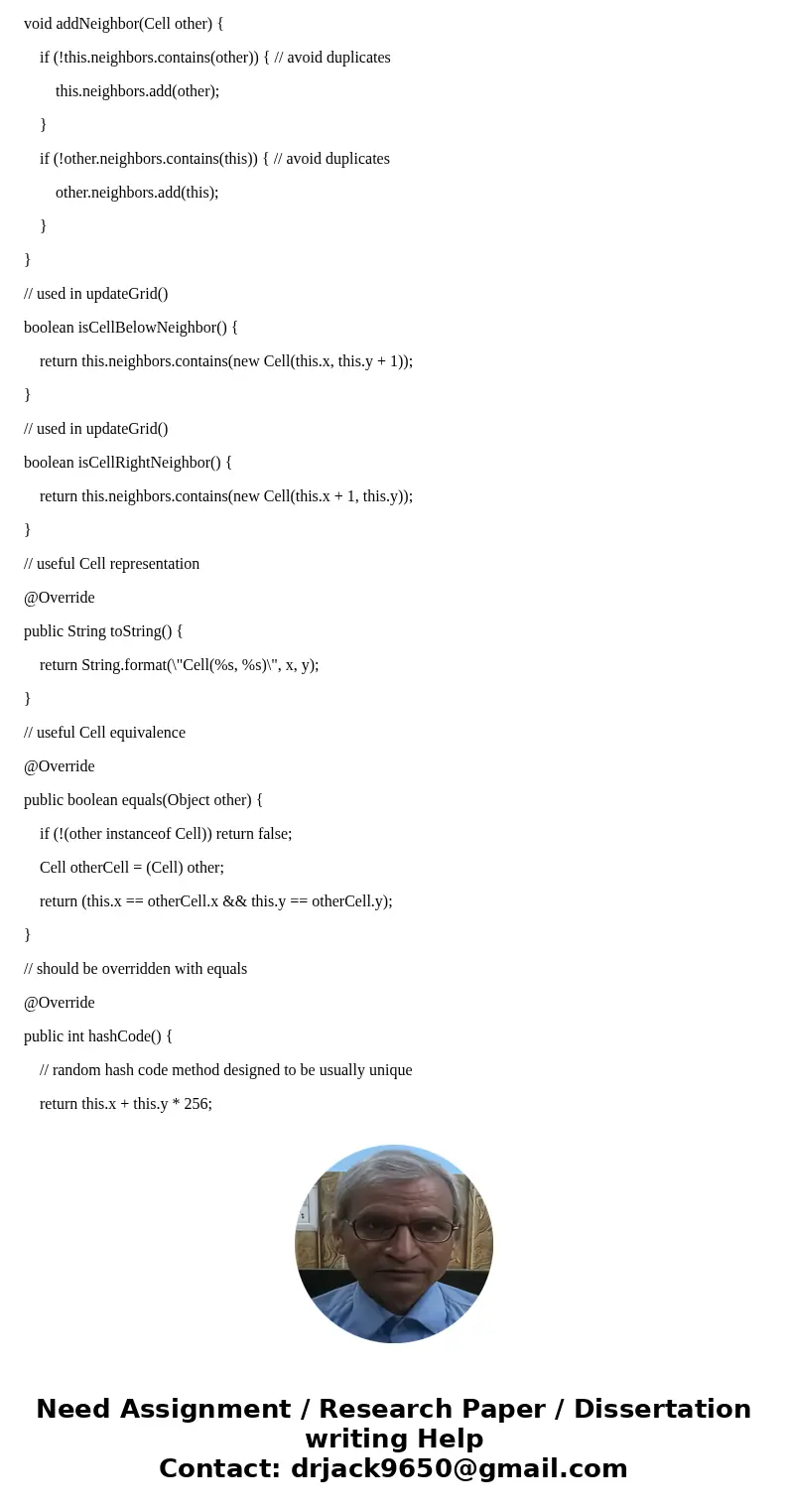
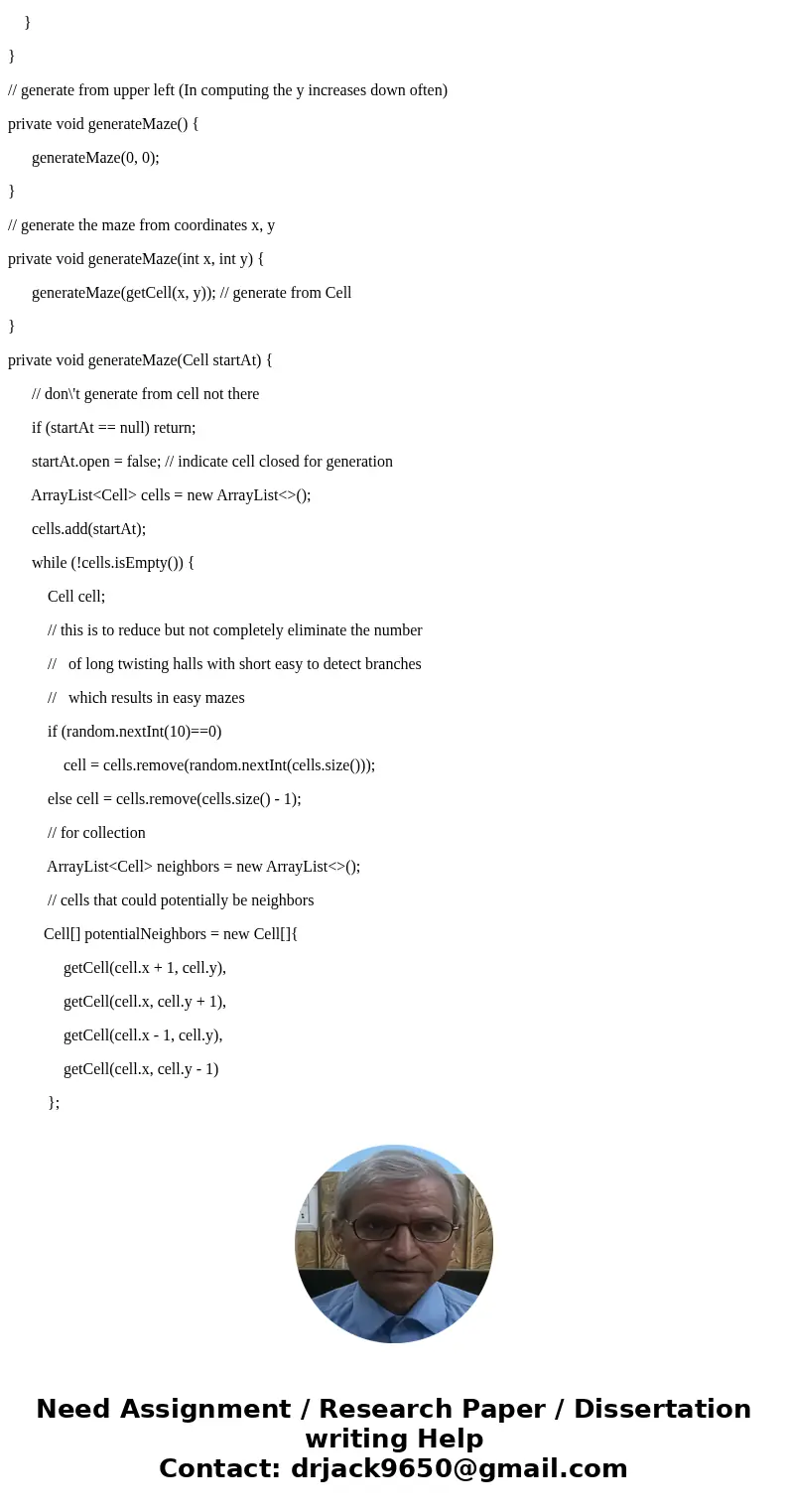
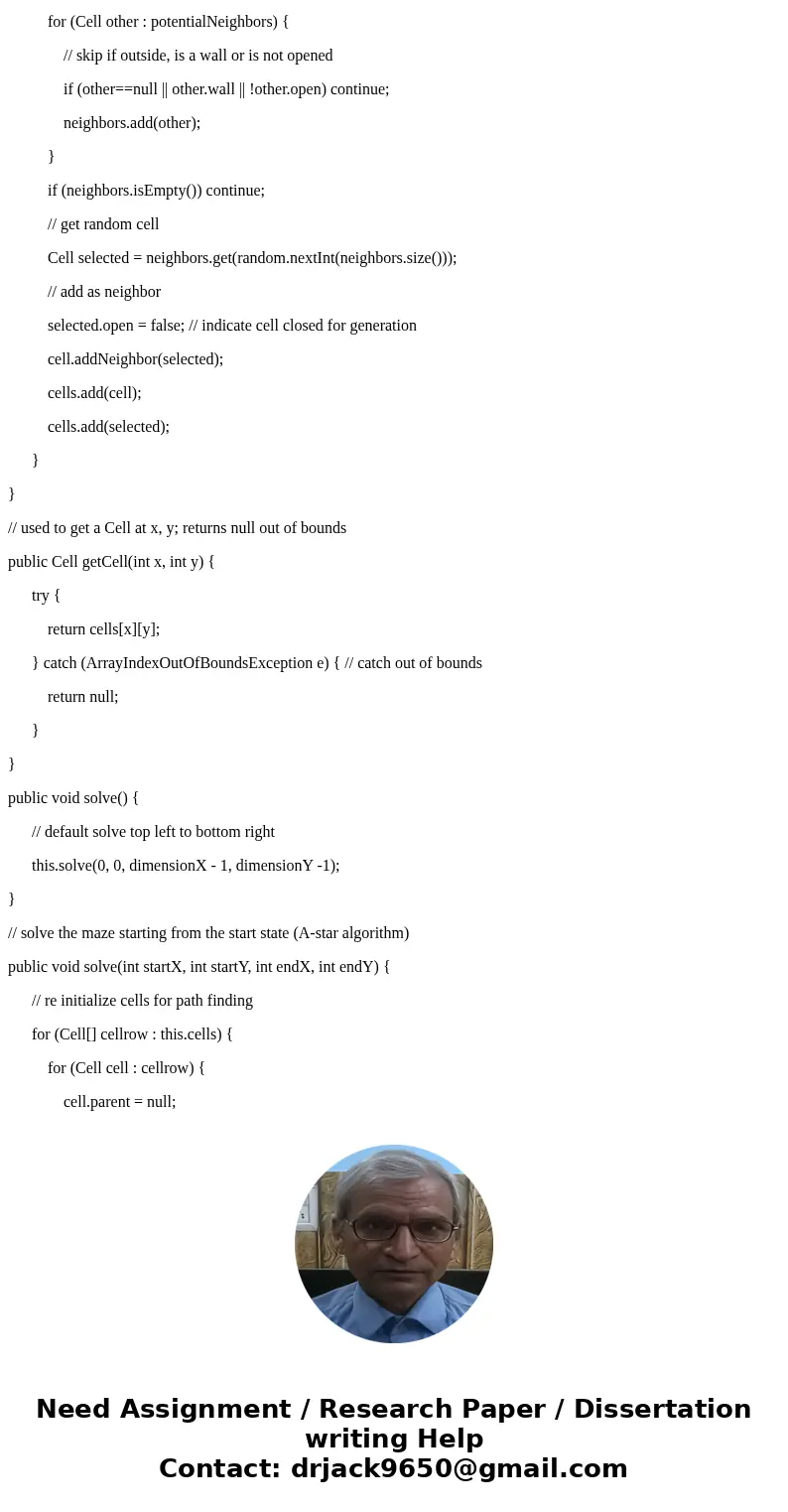
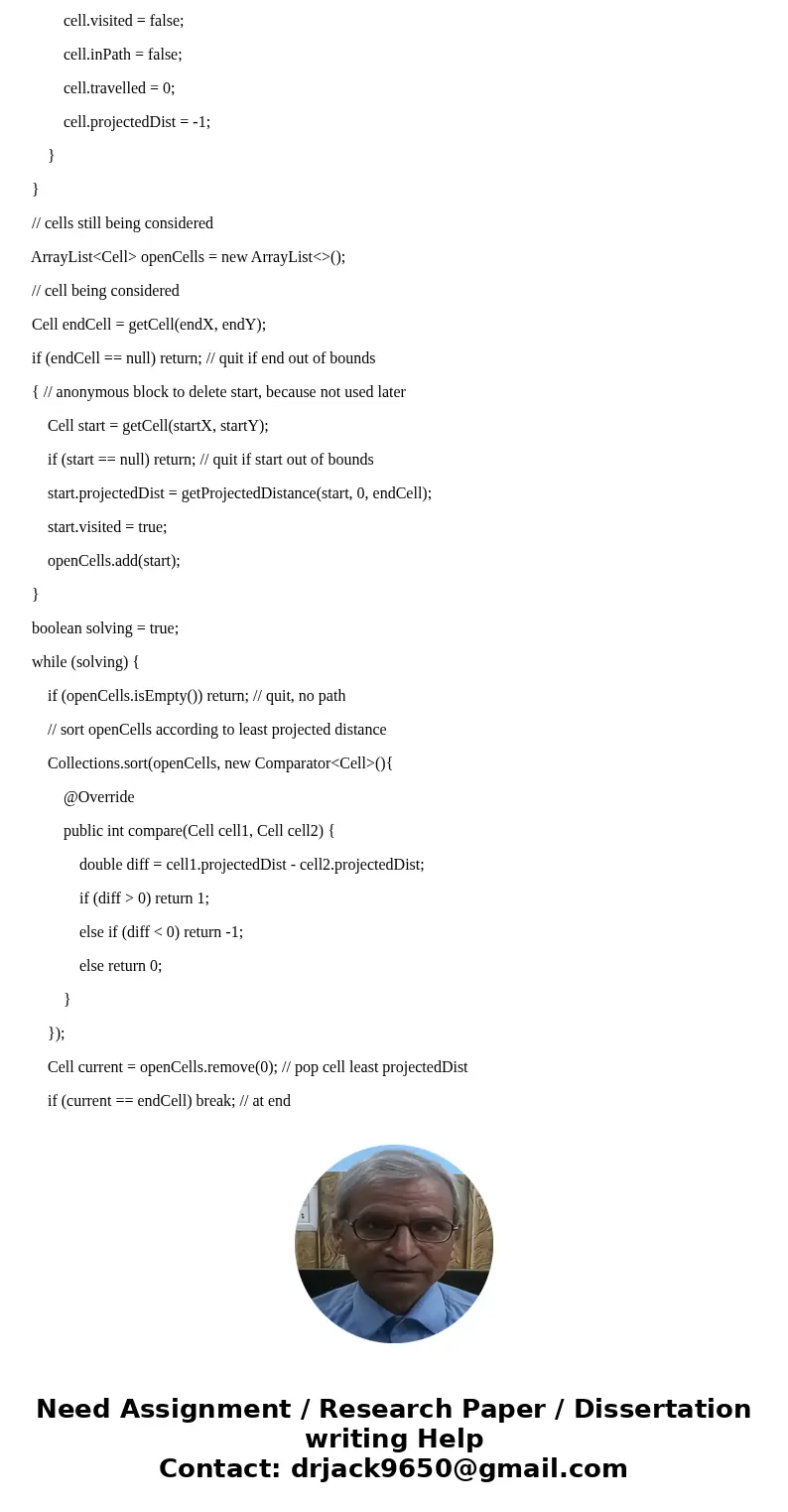
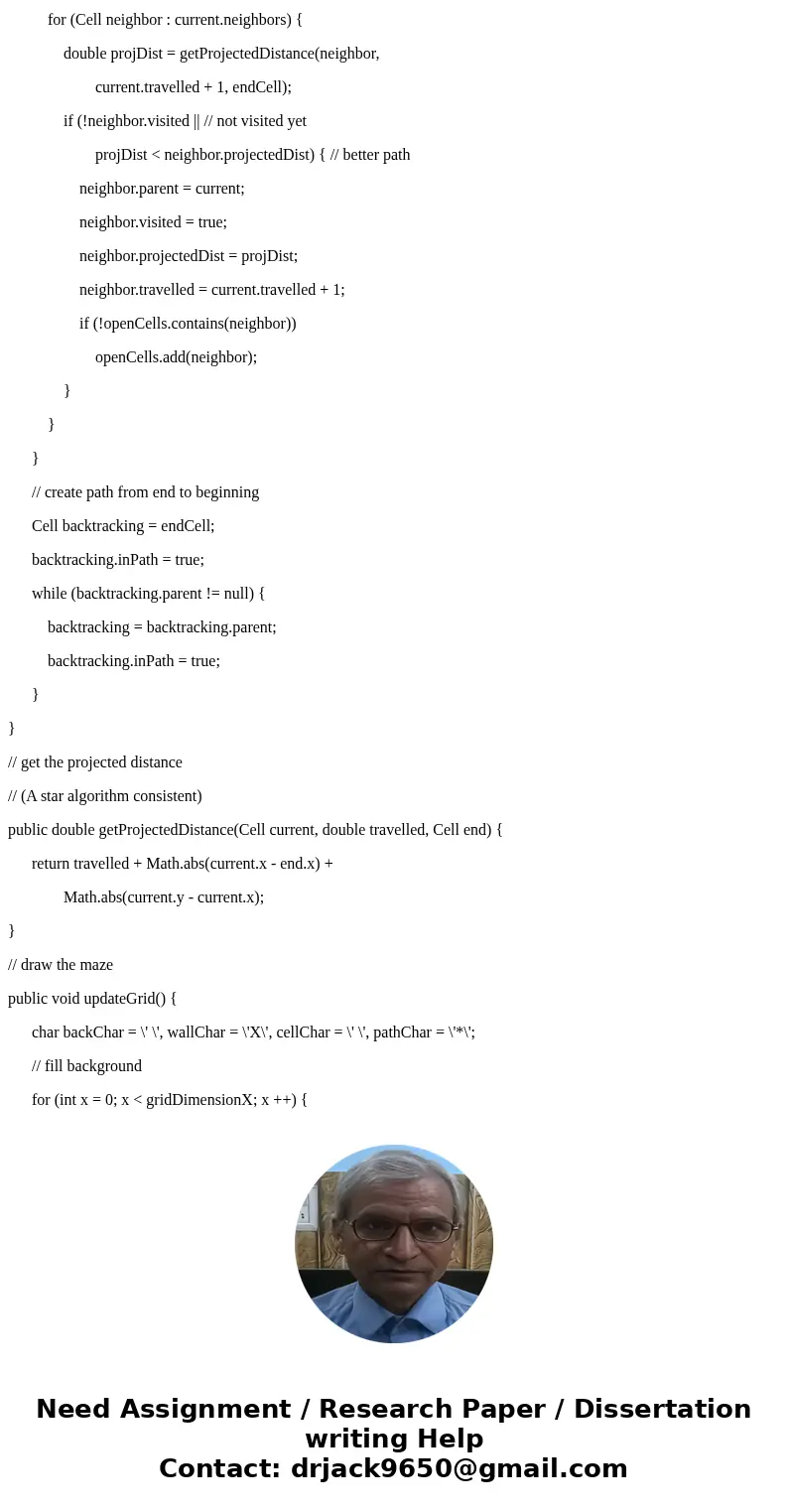
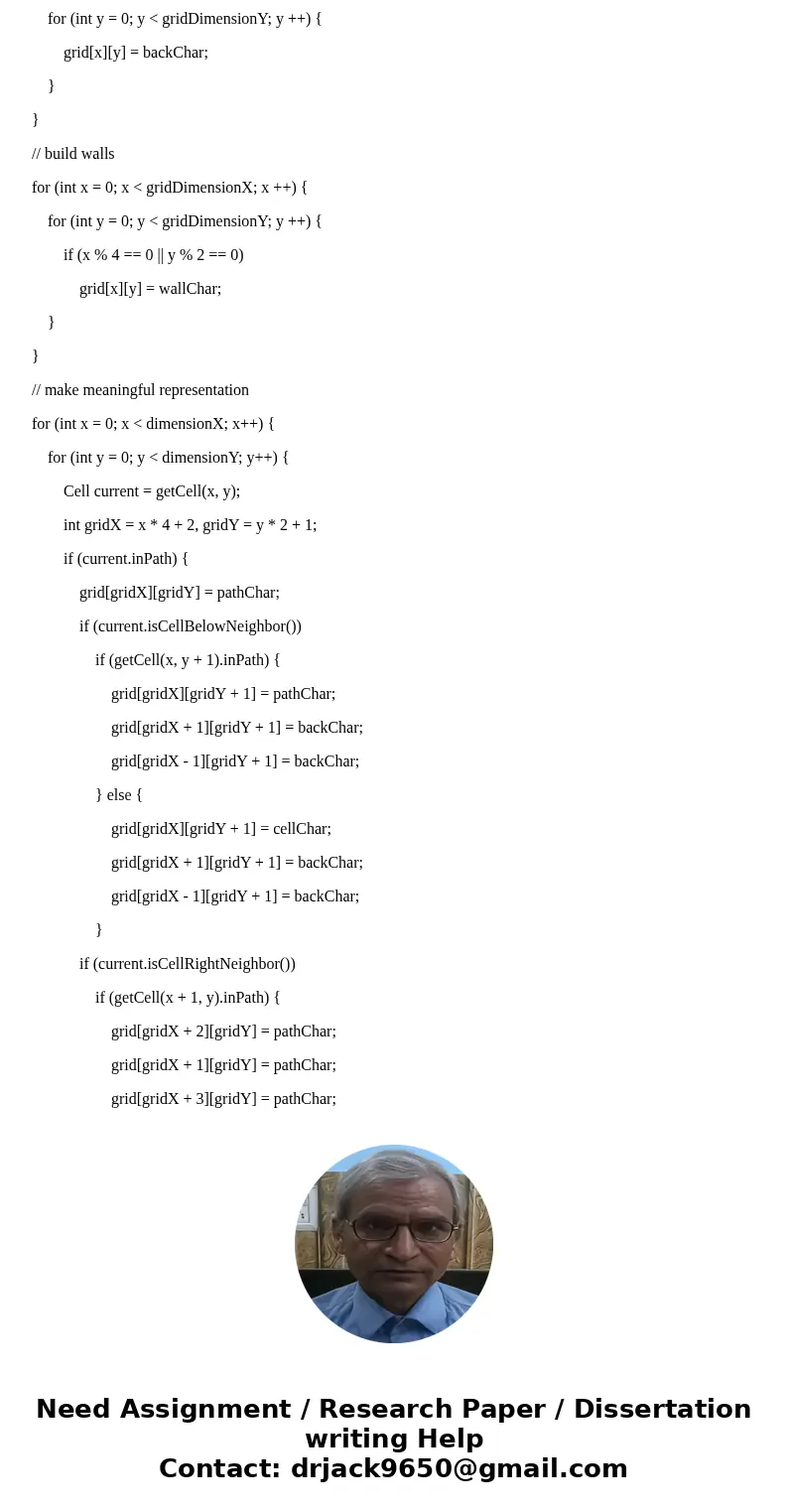
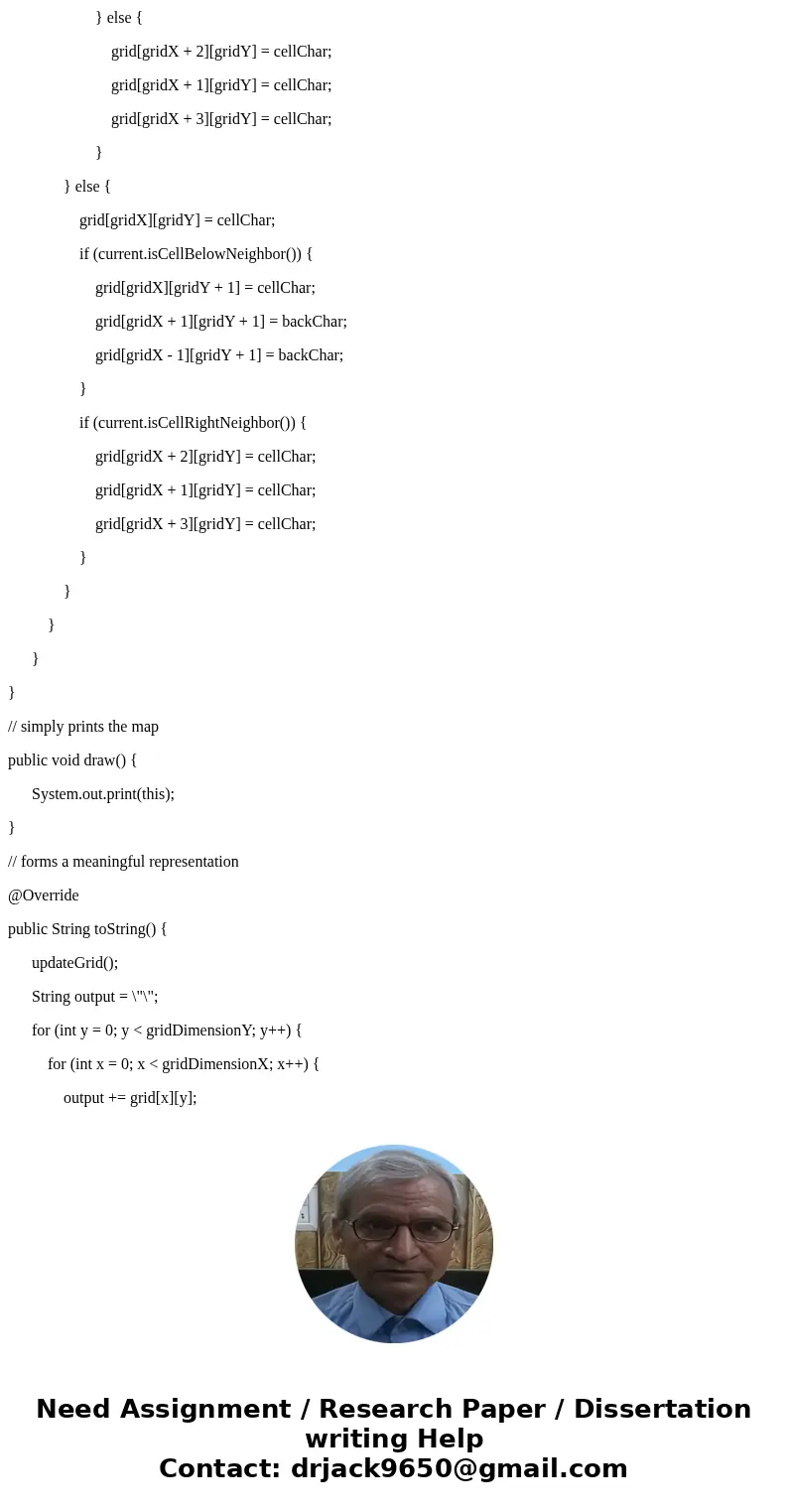
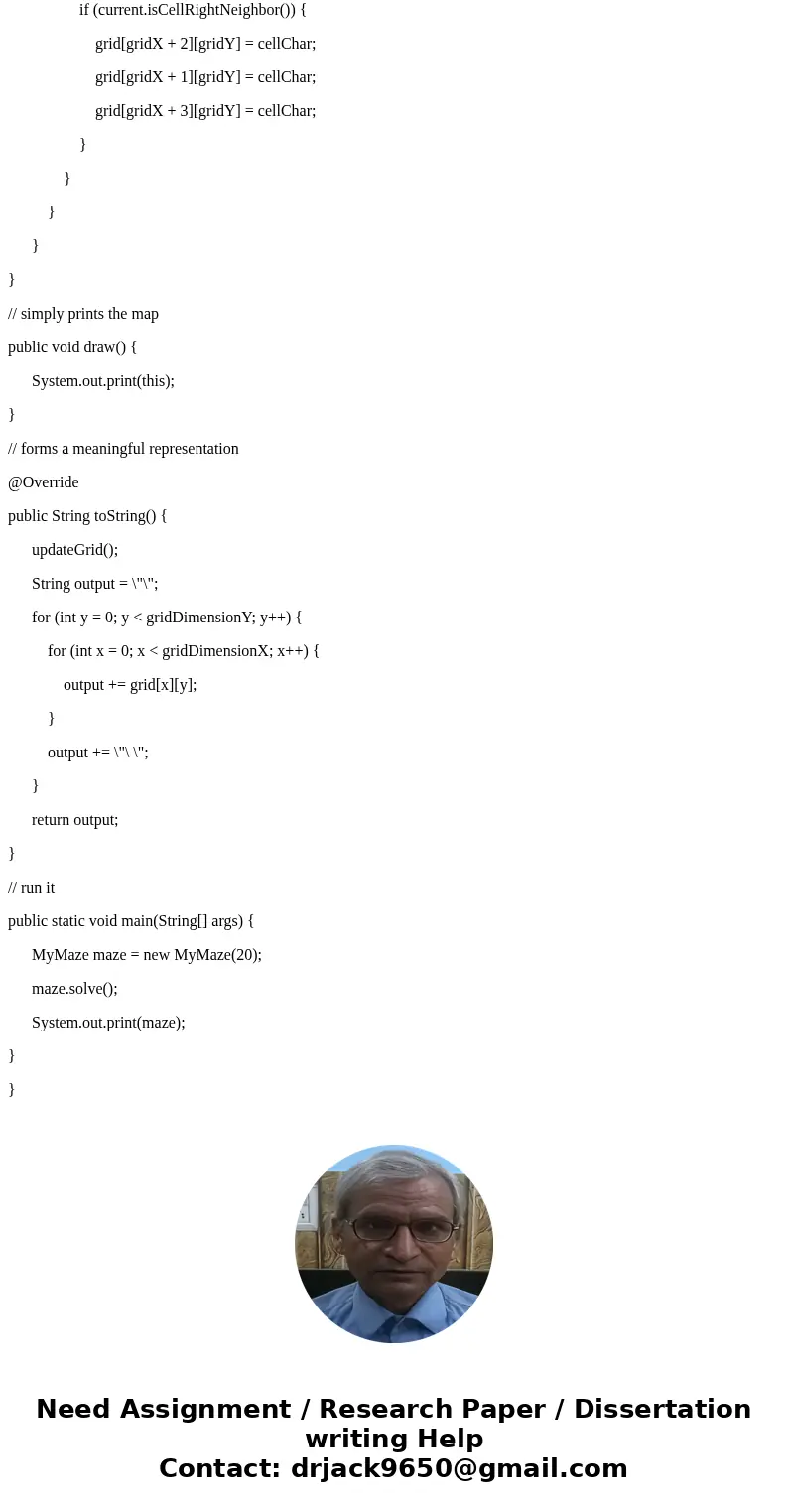
 Homework Sourse
Homework Sourse